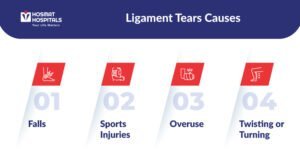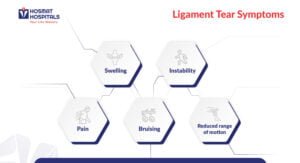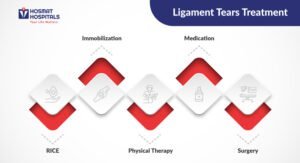
What is a Ligament Tear?
A ligament tear, or sprain, occurs when a ligament is stretched or torn beyond its capacity. The severity of the tear can range from a mild strain (grade 1) to a complete rupture (grade 3).
Causes of Ligament Tears
Ligament tears often happen due to sudden, forceful movements that twist or hyperextend a joint. Common causes include:
- Falls: Landing awkwardly or tripping can put excessive stress on ligaments, especially in the ankle and knee.
- Sports Injuries: High-impact sports like football, basketball, and soccer often involve sudden twists and turns, which can lead to ligament tears.
- Overuse: Repetitive stress on a ligament, common in sports that require repetitive movements such as running, jumping, or lifting, can lead to overuse injuries and tears.
- Twisting or Turning: Abrupt twisting or turning movements, particularly in the knee or ankle, can cause the ligaments to stretch and tear.
Signs and Symptoms of a Ligament Tear
The telltale signs of a ligament tear can vary depending on the severity of the injury, but some common symptoms include:
- Pain: This is the most common symptom, ranging from a dull ache to sharp pain.
- Swelling: Inflammation around the injured joint is a natural response to the tear.
- Bruising: Blood vessels can rupture with a tear, causing skin discolouration.
- Instability: The joint may feel loose or wobbly, making movement difficult.
- Reduced range of motion: Joint movement may be limited depending on the tear.
Treatment Options for Ligament Tears
With proper treatment, most ligament tears will heal. The approach will vary based on the seriousness of the injury. Here’s a breakdown of standard treatment methods:
- RICE: Rest, Ice, Compression, and Elevation are the cornerstones of initial treatment. It reduces inflammation and promotes healing.
- Immobilization: In some cases, a splint or brace might be needed to immobilize the joint and prevent further damage.
- Physical Therapy: Exercises designed to strengthen the muscles and improve joint stability are crucial for recovery.
- Medication: Pain relievers and anti-inflammatory drugs can help manage pain and inflammation.
- Surgery: In severe cases with complete ligament tears, surgery may be necessary to repair the damaged tissue.
Conclusion
Ligament tears are a significant concern for anyone involved in physical activities or sports. For effective management and prevention, it is essential to understand the causes, symptoms, and treatment options. The earliest diagnosis and appropriate treatment can ensure a successful recovery and a quick return to normal activities. If you suspect a ligament tear, Seek prompt medical attention from the best orthopedic hospital in Bangalore for specialized care and a swift return to normal activities.
Disclaimer: This blog is intended for educational purposes only and should not be interpreted as medical advice. For any health concerns or medical questions, please consult your healthcare provider. The information provided here is not a substitute for professional medical guidance, diagnosis, or treatment.





